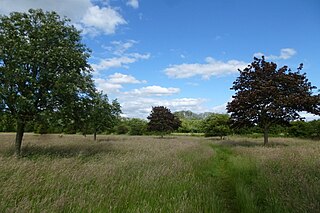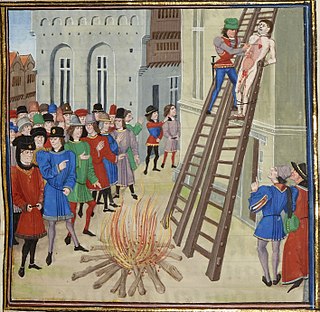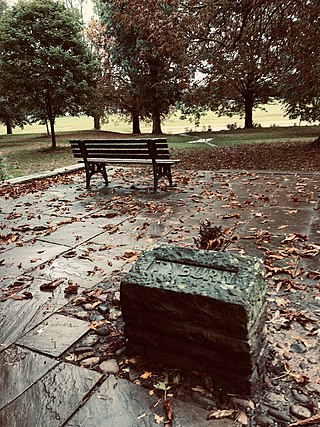Posthumous execution is the ritual or ceremonial mutilation of an already dead body as a punishment. It is typically performed to show that even in death, one cannot escape justice.

Tyburn was a manor (estate) in the county of Middlesex, England, one of two which were served by the parish of Marylebone. Tyburn took its name from the Tyburn Brook, a tributary of the River Westbourne. The name Tyburn, from Teo Bourne, means 'boundary stream'.

Newgate Prison was a prison at the corner of Newgate Street and Old Bailey Street just inside the City of London, England, originally at the site of Newgate, a gate in the Roman London Wall. Built in the 12th century and demolished in 1904, the prison was extended and rebuilt many times, and remained in use for over 700 years, from 1188 to 1902.

Richmond is a market town and civil parish in the district and county of North Yorkshire, England. It is in the Swaledale valley, near the River Swale, and on the eastern edge of the Yorkshire Dales National Park. The town has become a tourist centre for the park. The town's population at the 2011 census was 8,413. The town is 16 miles (26 km) from the local government district's administrative centre in Northallerton.

Albert Pierrepoint was an English hangman who executed between 435 and 600 people in a 25-year career that ended in 1956. His father Henry and uncle Thomas were official hangmen before him.

A gallows is a frame or elevated beam, typically wooden, from which objects can be suspended or "weighed". Gallows were thus widely used to suspend public weighing scales for large and heavy objects such as sacks of grain or minerals, usually positioned in markets or toll gates. The term was also used for a projecting framework from which a ship's anchor might be raised so it is no longer sitting on the seabed, riverbed or dock; "weighing [the] anchor" meant raising it using this apparatus while avoiding striking the ship's hull.

York Racecourse is a horse racing venue in York, North Yorkshire, England. It is the third biggest racecourse in Britain in terms of total prize money offered, and second behind Ascot in prize money offered per meeting. It attracts around 350,000 racegoers per year and stages three of the UK's 36 annual Group 1 races – the Juddmonte International Stakes, the Nunthorpe Stakes and the Yorkshire Oaks.

Alexandra Park is a 200 acre (80–hectare), Green Flag Award, and Green Heritage winning, diverse-landscape park, in the Borough of Haringey in north London adjacent to Hornsey, Muswell Hill and Wood Green. Laid out on the site of Tottenham Wood and the later Tottenham Wood Farm, the park and palace were named in 1863, the year of the marriage of Alexandra of Denmark to the Prince of Wales who became King Edward VII.

William Wynne Ryland was an English engraver, who pioneered stipple engraving and was executed for forgery.

Catterick is a village, civil parish and electoral ward in the Richmondshire district of North Yorkshire, England. Historically part of the North Riding of Yorkshire, it is 8.5 miles (13.7 km) north-west of the county town of Northallerton just to the west of the River Swale. It lends its name to nearby Catterick Garrison and the nearby hamlet of Catterick Bridge, the home of Catterick Racecourse where the village Sunday market is held. It lies on the route of the old Roman road of Dere Street and is the site of the Roman fortification of Cataractonium.

The Strays of York is a collective name for four areas of open land, comprising in all over 800 acres (3.2 km2), within the City of York. Their individual names are Bootham Stray, Micklegate Stray, Monk Stray and Walmgate Stray.
The Douai Martyrs is a name applied by the Catholic Church to 158 Catholic priests trained in the English College at Douai, France, who were executed by the English state between 1577 and 1680.
Sir Robert Constable was a member of the English Tudor gentry. He helped Henry VII to defeat the Cornish rebels at the Battle of Blackheath in 1497. In 1536, when the rising known as the Pilgrimage of Grace broke out in the north of England, Constable was one of the insurgent leaders, but towards the close of the year, he submitted at Doncaster and was pardoned. He did not share in the renewal of the rising, Bigod's rebellion, which took place in January 1537; but he refused the king's invitation to proceed to London, and was arrested, tried for treason, and hanged at Hull in the following June.

To be hanged, drawn and quartered became a statutory penalty for men convicted of high treason in the Kingdom of England from 1352 under King Edward III (1327–1377), although similar rituals are recorded during the reign of King Henry III (1216–1272). The convicted traitor was fastened to a hurdle, or wooden panel, and drawn by horse to the place of execution, where he was then hanged, emasculated, disembowelled, beheaded, and quartered. His remains would then often be displayed in prominent places across the country, such as London Bridge, to serve as a warning of the fate of traitors. For reasons of public decency, women convicted of high treason were instead burned at the stake.
Bigod's rebellion of January 1537 was an armed rebellion by English Roman Catholics in Cumberland and Westmorland against King Henry VIII of England and the English Parliament. It was led by Sir Francis Bigod, of Settrington in the East Riding of Yorkshire.
Alexander Rawlins was an English Roman Catholic martyr, beatified in 1929.
Marcy Clay alias Jenny Fox, was an English thief and highwayrobber, and subject of the 1665 pamphlet The high-way woman, or, A true and perfect narrative of the wicked life, and deplorable death of Marcy Clay.

York Debtor's Prison is a former Debtor's prison and Grade I Listed building located in York, North Yorkshire. Since 1952 it has been part of the York Castle Museum.

The Female Prison is a former women's prison and a Grade I Listed building located in York, North Yorkshire. Since 1938 it has been part of the York Castle Museum.

Elizabeth Broadingham was a British murderer. She was executed in 1776 with her lover for the murder of her husband in York. Her husband was considered to be her social superior so she was one of the last women to be burned at the stake.


















